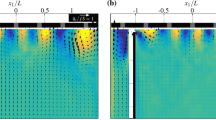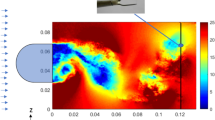Abstract
The accuracy of turbulent kinetic energy (TKE) dissipation rate measured by PIV is studied. The critical issue for PIV-based dissipation measurements is the strong dependency on the spatial resolution, Δx, as reported by Saarenrinne and Piirto (Exp Fluids Suppl:S300–S307, 2000). When the PIV spacing is larger than the Kolmogorov scale, η, the dissipation is underestimated because the small scale fluctuations are filtered. For the case of Δx smaller than the Kolmogorov scale, the error rapidly increases due to noise. We introduce a correction method to eliminate the dominant error for the small Δx case. The correction method is validated by using a novel PIV benchmark, random Oseen vortices synthetic image test (ROST), in which quasi-turbulence is generated by randomly superposing multiple Oseen vortices. The error of the measured dissipation can be more than 1,000% of the analytical dissipation for the small Δx case, while the dissipation rate is underestimated for the large Δx case. Though the correction method does not correct the underestimate due to the low resolution, the dissipation was accurately obtained within a few percent of the true value by using the correction method for the optimal resolution of η/10 < Δx < η/2.







Similar content being viewed by others
References
Antonia RA, Mi J (1993) Corrections for velocity and temperature derivatives in turbulent flows. Exp Fluids 14:203–208
Antonia RA, Pearson BR (2000) Effect of initial conditions on the mean energy dissipation rate and the scaling exponent. Phys Rev E 62(6):8086–8090
Antonia RA, Zhu Y, Kim J (1993) On the measurement of lateral velocity derivatives in turbulent flows. Exp Fluids 15:65–69
Antonia RA, Zhu Y, Kim J (1994) Corrections for spatial velocity derivatives in a turbulent shear flow. Exp Fluids 16:411–413
Bendat JS, Piersol AG (2000) Random data analysis and measurement procedures. Wiley, Canada
Burattini P, Lavoie P, Antonia RA (2005) On the normalized turbulent energy dissipation rate. Phys Fluids 17:098103
Chen J, Katz J (2005) Elimination of peak-locking error in PIV analysis using the correlation mapping method. Meas Sci Technol 16:1605–1618
Eaton JK, Tanaka T (2006) Particle interaction with homogeneous turbulence. Forty Fourth AIAA Aerosp Sci Meet Exhibit 44:1–3
Ferziger JH (1981) Numerical methods for engineering application. Wiley, London
Gui L, Wereley ST (2002) A correlation-based continuous window-shift technique to reduce the peak-locking effect in digital PIV image evaluation. Exp Fluids 32:506–517
Hart DP (2000) PIV error correction. Exp Fluids 29:13–22
Huang H, Fiedler H, Wang J (1993) Limitation and improvement of PIV: part II. Particle image distortion, a novel technique. Exp Fluids 15(263):73
Kaneda Y, Ishihara T, Yokokawa M, Itakura K, Uno A (2003) Energy dissipation rate and energy spectrum in high resolution direct numerical simulations of turbulence in a periodic box. Phys Fluids 15(2):L21–L24
Liu X, Thomas FO (2004) Measurement of the turbulent kinetic energy budget of a planar wake flow in pressure gradients. Exp Fluids 37:469–482
Lumley JL (1992) Some comments on turbulence. Phys Fluids 4:203–211
Pearson BR, Krogstad PA, Water W (2002) Measurements of the turbulent energy dissipation rate. Phys Fluids 13(3):1288–1290
Pearson BR, Yousef TA, Haugen NEL, Brandenburg A, Krogstad PA (2004) Delayed correlation between turbulent energy injection and dissipation. Phys Rev E 70:056301
Raffel M, Willert C, Kompenhans J (1998) Particle image velocimetry. Springer, Heidelberg, p 144
Roth GI, Katz J (2001) Five techniques for increasing the speed and accuracy of PIV interrogation. Meas Sci Technol 12:238–245
Saarenrinne P, Piirto M (2000) Turbulent kinetic energy dissipation rate estimation from PIV vector fields. Exp Fluids Suppl:S300–S307
Saarenrinne P, Piirto M, Eloranta H (2001) Experiences of turbulence measurement with PIV. Meas Sci Technol 8:1393–1398
Sreenivasan KR (1984) On the scaling of the turbulence energy dissipation rate. Phys Fluids 27(5):1048–1051
Sreenivasan KR (1998) An update on the energy dissipation rate in isotropic turbulence. Phys Fluids 10(2):528–529
Westerweel J (1997) Fundamentals of digital particle image velocimetry. Meas Sci Technol 8:1379–1392
Willert CE, Gharib M (1991) Digital particle image velocimetry. Exp Fluids 10:181–193
Wyngaard JC (1968) Measurement of small-scale turbulence structure with hot wires. J Sci Instrum (J Phys E) 1:1105–1108
Wyngaard JC (1969) Spatial resolution of the vorticity meter and other hot wire arrays. J Sci Instrum (J Phys E) 2:983–987
Acknowledgments
This research was supported by NASA grant NCC3-640.
Author information
Authors and Affiliations
Corresponding author
Rights and permissions
About this article
Cite this article
Tanaka, T., Eaton, J.K. A correction method for measuring turbulence kinetic energy dissipation rate by PIV. Exp Fluids 42, 893–902 (2007). https://doi.org/10.1007/s00348-007-0298-y
Received:
Revised:
Accepted:
Published:
Issue Date:
DOI: https://doi.org/10.1007/s00348-007-0298-y




